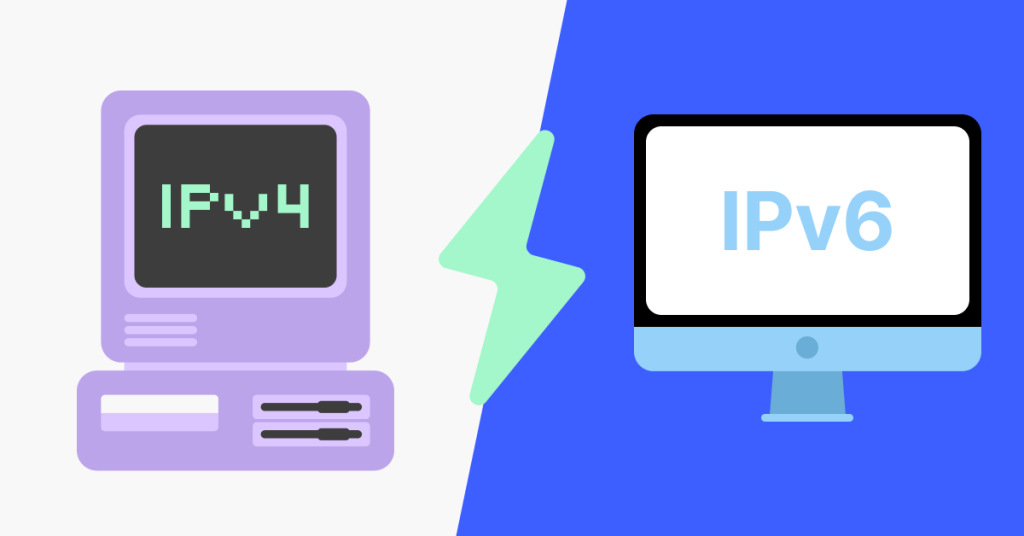
Table of Contents
IPv4 and IPv6 (Internet Protocol version 6) are two versions of the Internet Protocol, which is a set of rules for routing and addressing packets of data so that they can travel across networks and arrive at the correct destination.
IPv4 (Internet Protocol version 4)
Key Features:
- Address Format: IPv4 addresses are 32-bit numbers, typically represented in decimal format as four octets (8-bit segments) separated by periods. For example,
192.168.1.1. - Address Space: IPv4 supports approximately 4.3 billion unique addresses (2^32 addresses).
- Header Size: The IPv4 header is 20 to 60 bytes long.
- Fragmentation: IPv4 allows for packet fragmentation to accommodate different MTU (Maximum Transmission Unit) sizes across networks.
- Checksum: IPv4 includes a checksum in the header to detect errors in the header.
- Broadcast: IPv4 supports broadcast addressing, allowing a packet to be sent to all hosts on a network.
- NAT (Network Address Translation): Due to the limited address space, IPv4 often relies on NAT to allow multiple devices on a local network to share a single public IP address.
Limitations:
- Address Exhaustion: The primary limitation of IPv4 is the exhaustion of available addresses due to the growth of the internet and the proliferation of devices requiring unique IP addresses.
- Security: While security protocols like IPsec can be used with IPv4, they are not built into the protocol.
IPv6 (Internet Protocol version 6)
Key Features:
- Address Format: IPv6 addresses are 128-bit numbers, represented in hexadecimal format as eight groups of four hexadecimal digits separated by colons. For example,
2001:0db8:85a3:0000:0000:8a2e:0370:7334. Leading zeros in each group can be omitted, and consecutive groups of zeros can be replaced with::(but only once per address). - Address Space: IPv6 supports approximately 340 undecillion (3.4 x 10^38) unique addresses (2^128 addresses), providing a vastly larger address space.
- Header Size: The IPv6 header is 40 bytes long, with a simplified header format that improves processing efficiency.
- Fragmentation: Fragmentation in IPv6 is handled by the source device rather than routers along the path, improving efficiency.
- Checksum: IPv6 does not include a header checksum, relying instead on lower-layer checksums (like those in TCP/UDP) to ensure data integrity.
- No Broadcast: IPv6 does not support broadcast addressing. Instead, it uses multicast and anycast addressing methods.
- Auto-configuration: IPv6 supports stateless address auto-configuration (SLAAC), allowing devices to configure themselves automatically when connected to an IPv6 network.
- Security: IPv6 has built-in support for IPsec, providing end-to-end encryption and authentication.
Advantages:
- Expanded Address Space: The vast address space of IPv6 ensures that the world will not run out of IP addresses in the foreseeable future.
- Improved Performance: The simplified header and lack of need for NAT improve routing efficiency and performance.
- Built-in Security: Native support for IPsec in IPv6 enhances security.
Transition IPv4 and IPv6
The transition from IPv4 to IPv6 is ongoing and necessary due to the limitations of IPv4’s address space. Several techniques are used to facilitate this transition:
- Dual Stack: Devices run both IPv4 and IPv6, allowing them to communicate over either protocol.
- Tunneling: IPv6 packets are encapsulated within IPv4 packets to travel across IPv4 infrastructure.
- Translation: Network address translation techniques are used to translate between IPv4 and IPv6 addresses.
Summary
- IPv4: Uses 32-bit addresses, supports 4.3 billion addresses, and is widely deployed but limited by address exhaustion.
- IPv6: Uses 128-bit addresses, supports an extremely large number of addresses, offers improved efficiency, performance, and security, and is designed to replace IPv4.
The transition to IPv6 is critical for the continued growth and functionality of the internet, addressing the limitations of IPv4 and providing a foundation for future innovations in networking.